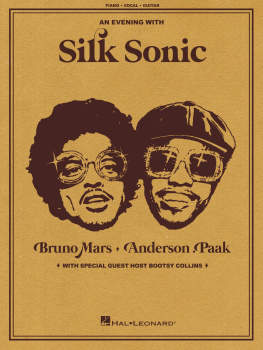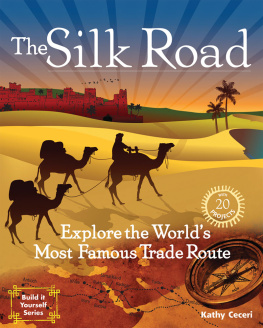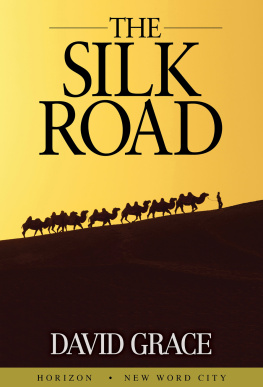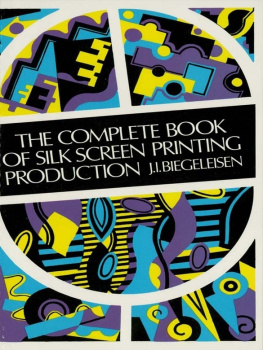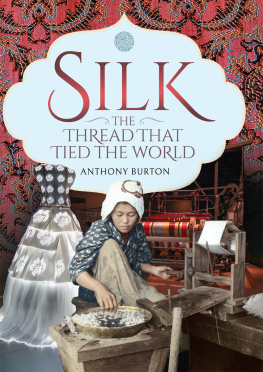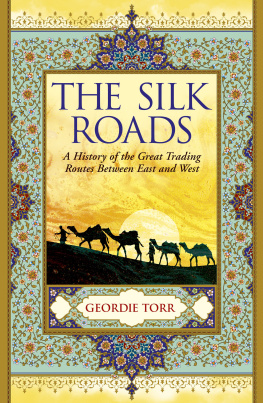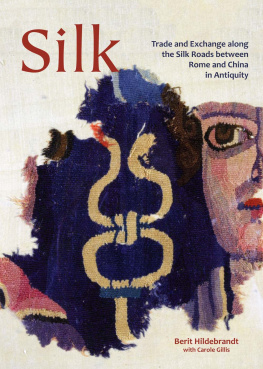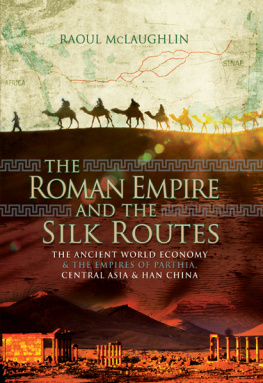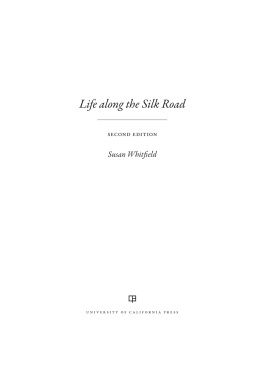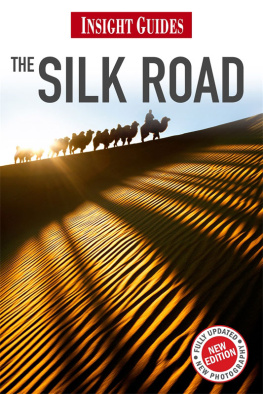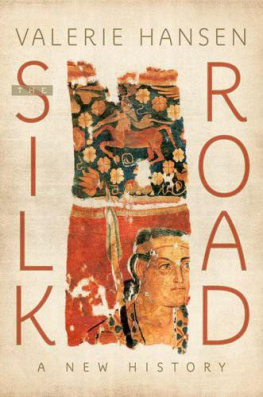
Ninth Century silk embroidery from Oseberg, Norway (No. C55000/377/12B1). Watercolour by Sofie Krafft. Museum of Cultural History, UIO
Published in the United Kingdom in 2014 by
OXBOW BOOKS
10 Hythe Bridge Street, Oxford OX1 2EW
and in the United States by
OXBOW BOOKS
908 Darby Road, Havertown, PA 19083
Oxbow Books and the individual contributors 2014
Paperback Edition: ISBN 978-1-78297-215-0
E-pub Edition: ISBN 978-1-78297-216-7; Mobi: ISBN 978-1-78297-217-4
PDF: ISBN 978-1-78297-218-1
A CIP record for this book is available from the British Library
Library of Congress Cataloging-in-Publication Data
Vedeler, Marianne.
Silk for the Vikings / Marianne Vedeler.
1 online resource. -- (Ancient textiles series ; Vol. 15)
Includes bibliographical references.
Description based on print version record and CIP data provided by publisher; resource not viewed.
ISBN 978-1-78297-216-7 (epub) -- ISBN 978-1-78297-217-4 (mobi) -- ISBN 978-1-78297
218-1 ( pdf ) -- ISBN 978-1-78297-215-0 1. Vikings--Clothing--Scandinavia. 2. Clothing and
dress--History--Medieval, 500-1500. 3. Textile fabrics, Viking--Scandinavia--History. 4. Silk-
Scandinavia--History. 5. Viking antiquities--Scandinavia. I. Title.
DL33.T48
382.456773909480902--dc23
2014013537
All rights reserved. No part of this book may be reproduced or transmitted in any form or by any
means, electronic or mechanical including photocopying, recording or by any information storage
and retrieval system, without permission from the publisher in writing.
For a complete list of Oxbow titles, please contact:
| UNITED KINGDOM | UNITED STATES OF AMERICA |
| Oxbow Books | Oxbow Books |
| Telephone (01865) 241249 | Telephone (800) 791-9354 |
| Fax (01865) 794449 | Fax (610) 853-9146 |
CONTENTS
LIST OF FIGURES
ACKNOWLEDGEMENTS
Many people have contributed to this book in various ways. Amongst them I should like to express my gratitude to my colleagues at the Museum of Cultural History and at Bergen Museum: Houshang Khazaei, Marina Prusac Lindhagen, Kaja Kollandsrud, Susan Braovac, Guro Hjulstad, Hanne Annestad, Jan Bill, Einar stmo, Ingunn M. Rstad, Anette Sttem, Svein Gullbekk and Gitte Hansen, for help, advice, constructive feedback and fruitful discussions. Houshang Khazaei has also kindly translated several passages from Persian texts. Thank you, Martin Ciszuk, for technical analysis of some of the Oseberg silks, and Loredana Boero at the Vatican Museums for technical analysis of a relic purse in Rome. Anne Hedeager Krag helped with the Danish silk finds and pointed out errors on one of the maps in the last minute!
Sophie Desrosiere gave me help and advice about the finds in France and Kirill Michailov and Anna Ierusalimskaja showed me the Russian finds in the State Hermitage Museum in St Petersburg. Thanks also go to Jessica Dijkman, Johan Arntzen and Torstein Sjvold for giving me permission to cite their works in progress. Thanks also to Krista Vajanto for introducing me to the Finnish silk finds and for translating passages from Finnish. Gerd Engh Kielland has drawn all the maps, and made many changes according to my changing wishes. Thanks for your good work and for your patience.
Nora Scholdager and Lars Lrdahl have been of invaluable help finding books through the University of Oslo Library. Menaka Roy copy edited the manuscript. Without kind and constructive critique and advices from Ulla Mannering, this book would have been different. Thank you, Ulla, for all your help! I am also grateful to the management at Museum of Cultural History for giving me the time and opportunity to follow my passion, and to Clare Litt and Tara Evans at Oxbow Books.
And last but not least; thank you, my friend and husband Arne Fredrik Nilsen, for your critical comments and kind support.
ABBREVIATIONS
BM | Bergen Museum |
KHM | Kulturhistorisk museum, Universitetet I Oslo (Museum of Cultural History, University of Oslo) |
NM | Nationalmuseet Kbenhavn (The National Museum of Denmark) |
SHM | Statens Historiska Museum (The Swedish History Museum) |
INTRODUCTION
This book is about the precious and beautiful items of woven silk, and of all the hands that touched them on their way to the far north in the Viking Age. My first serious introduction to Viking Age silk started with a museal audit on all items found in the Oseberg ship burial from the 9th century in Norway. The Museum of Cultural History at the University of Oslo, where I work, had decided to move the large collection of textiles to brand new storage facilities. Consequently, the collection had to be systematized and the textiles repacked. This work provided an opportunity to gain more insights into the textiles, as such processes often do. Searching for the context and meaning of these textiles, I found myself digging deeper into the background of the silk trade and exchange with Scandinavia during the Viking Age.
The Viking Age, with its expansions and conquests, but also its marvellous crafts, remains an important issue for Scandinavian identity and self-consciousness. I find, however, that the most fascinating thing about the silk finds from this period is the expression of plurality, of cultural meetings and of change. By the hands of Zoroastrian, Jewish, Muslim, Christian and heathen producers and tradesmen, the silk products found their way even to the lands far north. People over a large part of the world used similar products for different purposes and interpreted them with varied meaning.
The book focuses on the 9th and 10th centuries, with small digressions to both sides of this period. The first two chapters deal with silk products found in Scandinavia. Even though the number of silk finds from this period is small, new finds emerge as I write. The northernmost silk finds presented here, from a male burial in Ness in northern Norway, was still in preparation when this book was written. I hope that greater awareness about the existence of silk in Viking Age graves may lead to more finds.
Many of the Scandinavian silk finds await profound technical analysis, but contributing to this is not the main aim of this book. Instead, I wish to take a closer look at the trade routes and the organization of production, trade and consumption of silk during the Viking Age.
The book begins with a presentation of the silk finds in the Oseberg burial, which is the richest Viking burial find ever discovered. The other silk finds from high status graves in Scandinavia are presented in in the Byzantine Empire. These are the main areas of provenance for the silk products found in Scandinavian Viking Age graves. Chinese silk is very rarely found in Scandinavia, even if one or maybe two fragments of silk found in Sweden may have been made there. The large and complex silk production in China is therefore omitted. In the last chapter I have tried to look briefly at silk as a social actor in various contexts in Viking societies compared to the Christian west.
Chapter 1
SILK FROM THE SHIP BURIAL AT OSEBERG, NORWAY
The Oseberg grave mound is situated in the valley of Slagendalen in Vestfold, Norway. Two women were buried here in a large ship grave in the 9th century. This may be the richest and best preserved Viking Age grave discovered so far.
The mound was excavated in 1904 by Professor Gabriel Gustafson of the University of Oslo and his team. They discovered an extravagantly decorated and well preserved Viking ship and a large amount of artefacts. Items of personal adornment, household equipment, farming and textile tools and marine equipment were among the grave goods. Vehicles, including four sledges and a wagon, were placed in the forward section of the ship, where the remains of horses, dogs and oxen were also found. A triangular grave chamber hosted a large amount of personal equipment and textiles, among these well preserved silk fabrics. The Oseberg grave chamber is dated by dendrochronology to the year
Next page

